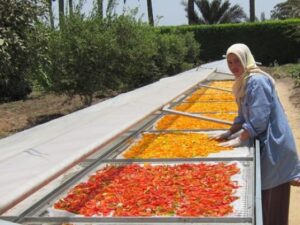What are Major Energy Sources in Rural Areas in the Future?
- In rural India, the sources of energy are diverse and can vary significantly based on geographic location, economic conditions, infrastructure availability, and cultural factors.
- Rural areas often have unique energy needs and limitations compared to urban areas. Due to the lack of access to modern infrastructure, rural communities rely on a combination of traditional and alternative energy sources to meet their energy demands.
- Here are some common energy sources used in rural areas:
Biomass Energy
- biomass materials such as wood, agricultural residues, animal dung, and crop waste are widely used in rural areas for cooking, heating, and lighting.
- Biomass pellets are used nowadays for cooking in rural areas
Solar Energy
- Solar energy is harnessed using solar panels to generate electricity for lighting, charging small electronic devices, and running basic appliances. Solar water heaters are also used for domestic hot water needs.
- Solar energy is used for drying of food items produced from agricultural forms like tomatoes, vegetables, grains, and cereals
Wind Energy
- In regions with consistent wind patterns, wind turbines can be installed to generate electricity.
- Wind energy is particularly useful for remote rural areas with limited access to the grid.
Hydroelectric Energy:
- Some rural areas have access to water bodies or small streams that can be harnessed to generate hydroelectric power.
- Micro-hydro systems can provide a reliable source of electricity.
Micro-Grids:
- These are localized power distribution networks that serve a small community or village.
- They can incorporate a combination of renewable energy sources and small-scale generators to provide reliable electricity.
Biogas Plant
- Biogas is produced by anaerobic digestion of organic materials such as animal waste, crop residues, and kitchen waste.
- It can be used for cooking, lighting, and heating, offering a cleaner alternative to traditional fuels.
Diesel Generators:
- In areas where grid electricity is unavailable or unreliable, diesel generators are commonly used to provide a consistent source of electricity, especially for powering essential services like schools and healthcare facilities.
Kerosene Lamps:
- While not a sustainable energy source, kerosene lamps are still used for lighting in some rural areas without access to electricity.
- However, these lamps are associated with indoor air pollution and safety risks.
Human and Animal Power:
- In some cases, manual labor or animal power is used for activities like pumping water, grinding grains, and other simple mechanical tasks.
Geothermal Energy:
- In regions with geothermal activity, geothermal energy can be harnessed for heating purposes or even for generating electricity.
Improved Cookstoves:
- While not an energy source per se, improved cookstoves are designed to increase the efficiency of biomass combustion, reduce fuel consumption, and decrease indoor air pollution.
Efficiency Measures:
- Implementing energy-efficient practices and appliances, such as LED lighting and energy-efficient appliances,
- LED lights can help reduce energy consumption in rural areas.
Solar Power Charging Stations:
- In areas with limited electricity access, mobile charging stations powered by solar panels or other renewable sources provide a way for people to charge their phones and other devices.
- Often, a combination of these energy sources is used to create a diversified and reliable energy supply that meets the unique needs of rural communities. Sustainable development and improving energy access in rural areas often involve a mix of modernizing traditional practices and introducing cleaner and more efficient technologies.
Why Biomass is most used in Rural Areas
- Biomass is most commonly used in rural areas for several reasons, primarily due to its availability, accessibility, and suitability to the local context.
- While biomass has numerous advantages in rural contexts, it’s important to note that traditional biomass burning can have negative consequences such as indoor air pollution, deforestation, and health issues.
- Transitioning to cleaner and more efficient biomass stoves or alternative energy sources when possible can help mitigate these challenges while still taking advantage of the benefits that biomass offers in rural areas.
- Here are some key factors that make biomass the preferred energy source in rural areas:
Abundant Resource:
- In many rural areas, biomass resources such as agricultural residues, wood, crop waste, and animal dung are readily available due to agricultural activities and the presence of forests.
- This makes biomass a convenient and accessible energy source for local communities.
Traditional Practices:
- Rural communities often have a historical reliance on biomass for cooking and heating.
- Traditional cooking methods using open fires or basic stoves are deeply ingrained in local cultures and habits, making biomass a familiar and culturally accepted choice.
Lack of Modern Energy Infrastructure:
- Rural areas, especially in developing countries, often lack access to modern energy infrastructure such as electricity and clean fuels.
- Biomass provides a readily available alternative for cooking and heating where alternatives like electricity or clean gas are limited or absent.
Economic Constraints:
- Biomass, being locally available, is often more affordable than alternative energy sources.
- Rural households with limited income may find it more feasible to utilize biomass for their energy needs rather than investing in expensive modern technologies.
Simple Technology:
- Traditional biomass stoves are relatively simple and can be made using locally available materials.
- This makes them easy to construct and repair, allowing communities to maintain and modify the stoves according to their needs.
Cooking Preferences:
- Biomass stoves are well-suited for traditional cooking practices,
- which involve slow cooking, simmering, and roasting. These stoves are often better equipped to handle the cooking styles and flavors preferred in rural communities.
Cultural Significance:
- Biomass-based cooking methods often hold cultural significance and are associated with traditional cuisine, flavors, and community gatherings. Switching to alternative energy sources might impact cultural practices and community dynamics.
Rural Livelihoods:
- In many rural areas, collecting biomass resources is also an economic activity that can provide livelihood opportunities for women and marginalized groups.
- This additional income source can play a crucial role in rural economies.
Local Control:
- Reliance on locally available biomass resources provides communities with a degree of control over their energy supply, reducing their vulnerability to external energy price fluctuations.
Limited Options:
- In some cases, rural areas might lack the necessary infrastructure to access cleaner and more efficient energy sources. Biomass becomes the default option due to the absence of alternatives.
Biomass stoves in Rural Areas
- provide 85-90% of the domestic energy and 75% of all rural energy.
- Biomass, including wood, agricultural residues (such as crop stalks and husks), and animal dung, remains a significant source of energy in rural areas.
- It is used for cooking, heating, and sometimes lighting in traditional stoves and open fires.
- However, this reliance on biomass has health and environmental implications, particularly indoor air pollution and deforestation.
Traditional Fuels like Kerosene
- In some regions, traditional fuels like cow dung cakes and crop residues are still used for cooking and heating.
- These are often readily available, but their use contributes to air pollution.
- Kerosene is used for lighting in many rural households that lack access to electricity.
- However, it has several drawbacks, including safety concerns, poor illumination, and reliance on government subsidies.
- A kerosene stove is commonly used for cooking in areas where access to cleaner and more modern cooking technologies is limited. Here’s how a kerosene stove is used for cooking:
- Fuel Preparation: The first step is to ensure that the kerosene stove’s fuel tank is filled with kerosene. The stove may have a separate fuel tank or a refillable canister that needs to be filled before cooking.
- Ignition: To start the cooking process, the user needs to ignite the burner. This is typically done using a match or a lighter. Some kerosene stoves may have a built-in ignition mechanism.
- Flame Adjustment: After ignition, the user can adjust the intensity of the flame by using the stove’s controls. These controls allow the user to increase or decrease the amount of fuel being burned, thus regulating the heat output.

Electricity from Solar Energy:
- The Indian government has been working to extend electricity access to rural areas through various initiatives, such as the “Saubhagya” scheme, which aims to provide electricity connections to every household.
- Renewable energy sources like solar power and small-scale hydroelectric projects are being deployed to improve rural electrification rates.
- Solar cells are used to generate electricity
Biogas Plant
- Biogas, generated from the anaerobic digestion of organic waste, is used in some rural areas for cooking and lighting.
- This source of energy has the advantage of being relatively clean and reducing dependence on traditional biomass.
LPG (Liquefied Petroleum Gas) Stove
- The government has promoted LPG as a cleaner cooking fuel, like “Pradhan Mantri Ujjwala Yojana. This scheme was focused to provide LPG connections to households below the poverty line.
- While LPG usage has increased in rural areas, challenges such as affordability and availability persist.
- However, the cost of LPG stove with gas cylinder is more than the a biomass wooden stove
- Mini-Grids: In some remote areas, decentralized mini-grids powered by renewable energy sources, such as solar or small-scale wind, are being implemented to provide electricity for lighting and other basic needs.
Micro hydraulic Power
- Micro-hydraulic power systems in rural areas refer to small-scale installations that utilize the energy generated by flowing water, such as streams or rivers, to generate electricity. These systems are often implemented in remote or off-grid regions where traditional power sources are scarce or unreliable.
- Economical support is provided by world banks to many African and Asian countries for establishment of the hydraulic turbine in rural areas
Parts of the hydraulic system
- Here’s an overview of how micro hydraulic power systems work in rural areas:
Water Source:
- Micro-hydraulic power systems require a consistent and reliable water source, such as a river or stream with a steady flow of water.
- The amount of available water flow and the height difference (head) between the water source and the turbine location determine the potential energy that can be harnessed.
Intake Structure:
- A system typically begins with an intake structure that diverts water from the source to the turbine.
- This structure should be designed to minimize environmental impact and prevent damage to aquatic life.
Penstock:
- The diverted water is channeled through a penstock, a pipe or channel that directs the water to the turbine.
- The pressure generated by the flowing water as it descends creates kinetic energy, which is then converted into mechanical energy by the turbine.
Turbine:
- The turbine is the core component of the micro-hydraulic power system.
- It consists of blades or buckets that capture the energy from the flowing water and convert it into mechanical rotational energy.
- There are different types of turbines suitable for micro hydro systems, such as Pelton, Francis, and Kaplan turbines.
- The choice depends on factors like water flow rate, head, and desired efficiency.
Generator:
- The mechanical energy generated by the turbine is then transferred to a generator.
- The generator converts this mechanical energy into electrical energy through electromagnetic induction.
- The generator produces an alternating current (AC) that can be used for local power consumption or stored in batteries for later use.
Control and Distribution:
- Micro-hydraulic power systems often include control mechanisms to regulate the amount of water flow to the turbine, ensuring stable and efficient power generation.
- The generated electricity can be distributed to local homes, farms, or other facilities, providing a reliable source of power for various needs.
Benefits of Micro Hydraulic Power
Renewable Energy Source:
- Micro-hydraulic power systems utilize the energy of flowing water, which is a renewable resource, making them environmentally friendly and sustainable.
Reliable Power Generation:
- Unlike solar and wind energy, which can be intermittent, water flow in rivers and streams tends to be more consistent, providing a stable source of power.
Reduced Dependence on Fossil Fuels:
- Micro-hydraulic power systems can reduce the reliance on diesel generators and other fossil fuel-based power sources, thereby reducing greenhouse gas emissions and air pollution.
Community Development:
- Access to electricity can significantly improve the quality of life in rural areas, supporting economic activities, education, healthcare, and communication.
Low Operating Costs:
- Once the initial infrastructure is in place, micro-hydraulic power systems generally have lower operating and maintenance costs compared to other power generation methods.
- However, it’s important to note that designing, installing, and maintaining micro-hydraulic power systems requires careful consideration of local geography, environmental impacts, regulatory requirements, and community engagement.
- Proper planning and sustainable practices are essential to ensure the long-term success and benefits of such systems in rural areas.
Conclusion
- It’s important to note that the energy landscape in rural India may have evolved since my knowledge cutoff date in 2021, and there may have been advancements in energy access and infrastructure.
- Additionally, government policies and initiatives continue to play a crucial role in shaping the energy mix in rural areas.
- For the most current information on the energy sources in rural India, it’s recommended to refer to recent government reports, energy surveys, and research conducted after 2023
- The choice of energy sources in rural areas depends on factors such as resource availability, technological feasibility, economic considerations, and environmental impacts.


















No comments:
Post a Comment